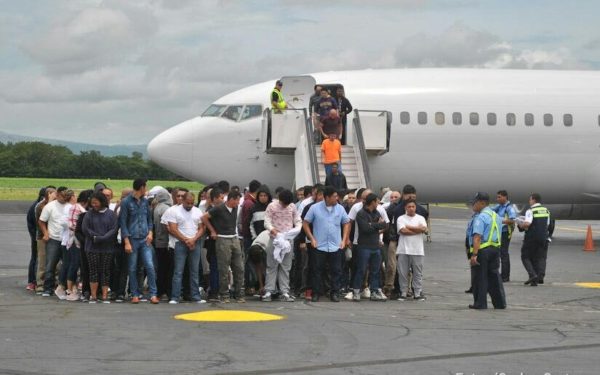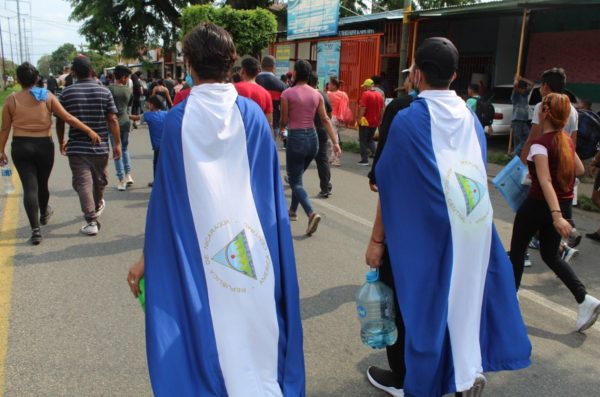United States Speeds up “Express Deportations” of Migrants

Immigration agents will decide who is eligible and immediately expel migrants who seek asylum without a “credible fear” of return.
HAVANA TIMES – As of this Tuesday, May 31, the Department of Homeland Security and the US Department of Justice began “implementing a rule to ensure that those people subject to expedited removal who are eligible for asylum get quick assistance, and those who do not be removed immediately.”
The so-called “Procedures for Credible Fear Screening and Consideration of Asylum, Withholding of Removal, and CAT Protection Claims by Asylum Officers” authorizes immigration asylum officers to decide who is eligible or should be “speedily” deported and this decision no longer rests solely with a judge.
The measure details that migrants seeking political asylum in the United States will be subject to the new rule in which they must prove fear of persecution or torture during their required verification, or else they will be immediately expelled.
“Due to existing court backlogs, the process to handle and decide these asylum cases currently takes several years on average. By establishing an effective and exhaustive revision process for asylum applications, the new rule will help to reduce existing backlogs in the immigration courts and shorten the process to several months,” the document states.
A gradual process
The measure notes that “due to existing backlogs in the courts, the process to attend and decide these asylum cases currently takes several years on average” and for that reason through a “gradual process,” and once fully implemented, the rule will shorten the administrative process from several years to several months.”
“People who qualify for asylum will receive protection more quickly, and those who are ineligible will be expelled immediately instead of remaining in the United States for years while their cases are pending,” they argue.
The document states that only individuals “who are placed in expedited removal proceedings after May 31, 2022, are potentially subject to the new process” and that the rule “does not apply to unaccompanied minors.”
Implementation will begin “with a small number of individuals” and will grow as the US Citizenship and Immigration Services (USCIS) “develops operational capacity.”
Firsts to apply it
The first locations for placement under this process will be two detention centers in Texas. They mention that asylum officials will conduct credible fear interviews by telephone at these two locations, “including for individuals who may subsequently be referred to USCIS for an asylum merit interview following a positive credible fear determination.”
They specify that “initially, referrals for asylum merit interviews will be limited to those individuals who indicate to USCIS and the US Immigration and Customs Enforcement (ICE) their intention to reside in one of the following six cities: Boston, Los Angeles, Miami, New York, Newark or San Francisco.
The procedure
They explain that people found by the Customs and Border Patrol Protection (CBP) at the border, who claim to be fearful, will be transferred to an ICE detention center.
Individuals will then be interviewed about their credible fear while in detention. Work will be done to provide them “the opportunity to access Legal Counselling Program providers prior to their credible fear interview.”
If the credible fear interview results in a negative decision, the individual may request a review of the decision by immigration judges (IJ). However, they note that USCIS “may also reconsider, at its discretion, a negative credible fear decision with which an immigration judge has concurred, if the request is filed within seven days subsequent to the immigration judge’s concurrence or prior to removal, whichever occurs first.”
Individuals who are place in removal and who receive a positive credible fear decision, and whom ICE determines on a case-by-case basis that release is appropriate, may be referred to USCIS for a non-confrontational asylum merit interview.
“The asylum merit interview will be conducted no sooner than 21 days and no later than 45 days after the positive credible fear decision,” according to the document.
If the USCIS “finds that the individual is eligible for asylum, the individual will receive a letter informing him or her of applicable benefits and related procedures.”
Nicaraguan migrants increased by 735%
The number of Nicaraguans who have migrated to the United States increased eightfold when comparing the first four months of 2021 and 2022, according to the numbers of apprehensions registered by immigration authorities of that country.
From January to April of last year, US authorities totaled 6,433 detentions Nicaraguan nationals at its borders; while between January and April of this year they already total 53,714, according to CBP figures.
Nicaraguan migration set a record last year, when more than 120,000 people departed to different countries, mainly to the United States (87,530 detentions of Nicaraguan at the US border). The strong migratory flow continues in 2022, at a rate that exceeds 10,000 Nicaraguans detected every month. That is, more than 300 daily, Confidencial recently reported.
The significant increase in migration from Nicaragua comes amid the deepening socio-political crisis that has persisted in the country since 2018, when massive citizens protests were crushed by the Ortega Murillo regime’s repression leaving more than 355 dead, thousands injured, hundreds of political prisoners and tens of thousands displaced.
In recent months, there have been increasing reports from family members of migrants kidnapped by cartels and criminal gangs in Mexico. Travelers have also denounced the inhumane conditions in which “coyotes” transport them, putting their lives at risk, such as the young pregnant Clorinda Alarcon, 20, who died last March suffocated inside a container in which she was travelling with dozens of people, including children.
It has also been reported that more than 20 Nicaraguans drowned in the Rio Bravo, which migrants must cross at various points along the US-Mexico border to turn themselves in to US authorities and request asylum or enter the US illegally.
In addition to the obstacles that put their physical integrity and lives at risk, there are the barriers derived from immigration policies imposed by the United States Government in its attempt to stem the flow, which so far this year has totaled almost 900,000 people. An example of this is the barbed wire fence along the banks of the Rio Bravo.
Nicaraguans most affected by “Stay in Mexico” program
In December of last year, the United States reinstated an immigration policy called Migrant Protection Protocols (MPP), known also as “Stay in Mexico,” which obliges migrants seeking asylum in the United States to remain in Mexico while their petition is being processed.
Since then, the policy has disproportionally affected Nicaraguan migrants, accounting for more than 60% of all returnees. This trend continues until last April, when 925 Nicaraguans were returned to Mexico. In total, more than 3,000 Nicaraguans have been returned to Mexican cities near the border since December of last year.
Title 42 also allows for “express” rejections
The other US regulation that slows down the entry of migrants into the country is Title 42, used since the beginning of the pandemic in 2020. This is a public health statute that allows the government to prevent the entry of people during public health emergencies. Despite some attempts by the Biden administration to eliminate the use of this regulation to reject migrants, this measure remains in place by a Louisiana judge’s decision made public last May 21. These are not deportations, but rather almost express rejections after which the migrants end up back in Mexico or sent back to their country of origin by plane.
Organizations that defend migrant populations have pointed out that the measure violates human rights because it prevents people from requesting international protection. Migrant families that include minors being processed under Title 42 cannot be removed and must be interviewed by asylum officials if they express fear of persecution or torture if they are returned to their country, according to a US court order made public on March 3.

US States borders “are not open” and the country will continue to reject migrants “when appropriate” under Title 42, recently said the Secretary of Homeland Security, Alejandro Mayorkas.
“The United States continues to enforce its immigration laws and the restrictions on our southern border have not changed,” the official stated in a message and a two-minutes video on his tweeter account. “Individuals and families remain subject to border restrictions, including rejection,” he added.
The organization Doctors Without Borders Mexico denounced that Title 42 is a regulation “that has nothing to do with health or the pandemic and is only a measure for the massive expulsion of migrants.”





